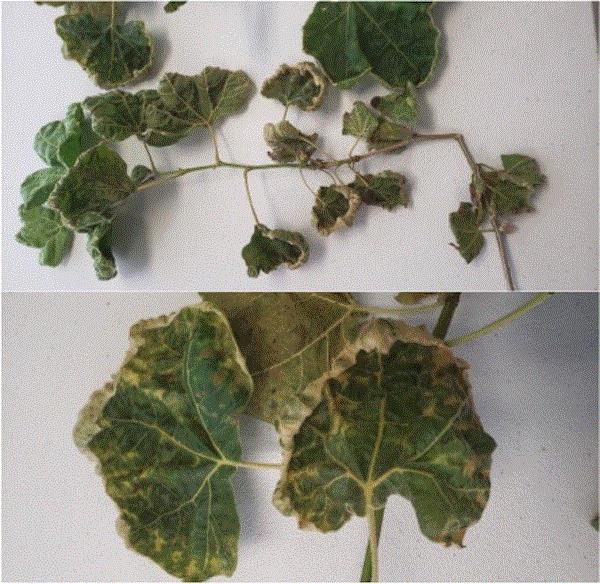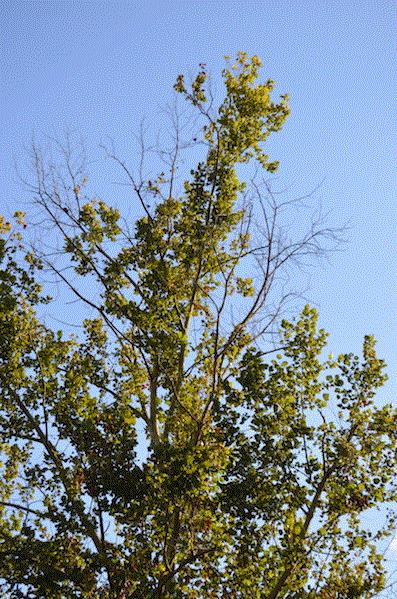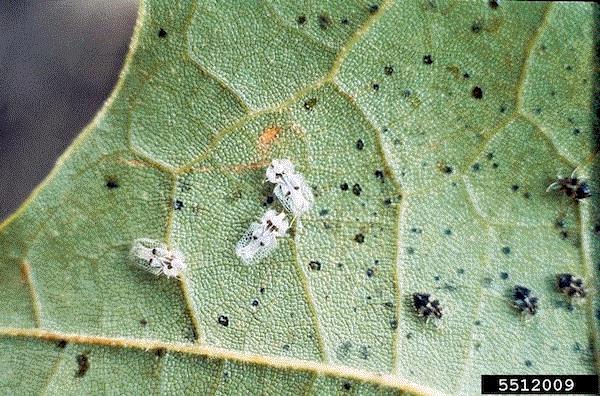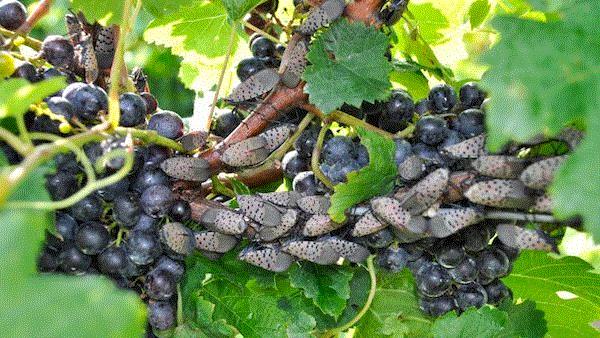What the … lace bug?
Trish DeHond, TJ Savereno and Paul Thompson (of Clemson University Extension Service) looped me in their email communication about damaged sycamore trees in several locations in South Carolina. Symptoms were sort of weird. The lower leaves are stippled and show bronzing, but the upper leaves were cupped, as if damaged by auxin herbicides.

Cupped leaves due to auxin herbicide damage? (Photo credit: Trish DeHond and TJ Savereno; Clemson University)
Still trying to sort out the cause of the cupped leaves, but the culprit of the leaf bronzing and stippling is the sycamore lace bug. A bug with “sycamore” in its name causing damage on sycamore? Yeah, what a big surprise!
I often wonder about the common names of some insects. For example, the fall armyworm shows up in my neck of the woods in June of most years, which is NOT fall in the Northern Hemisphere on any calendar (lunar, Julian, Gregorian or otherwise). I guess by the time the migrating hordes of fall armyworms reach New York, it’s already fall and the yankees get to name them FALL armyworms. Doesn't seem fair. Also, was the confused flour beetle named for its confusion after waking up from a carbohydrate-induced coma? Or was it that people are confused when they see the little red beetles feasting in their “tightly sealed” flour bag? I heard that the common name has its origin in the fact that the confused flour beetle looks so much like its cousin, the dust-red flour beetle, that folks often confuse the two species. Nah, I don't buy that.
I’m not confused about why the sycamore lace bug is named so. It only feeds on members of the plane tree genus (Platanus), including sycamore (the main host), London planetree and oriental sycamore. This species is native to eastern U.S. and Canada, yet it has spread to at least 29 countries. It was first discovered in Europe (Italy) in 1964, South America (Chile) before 1990, Asia (Korea) in 1995 and Australia in 2006.
There is not a comprehensive assessment of its pest status, but I’ve seen damaged sycamore everywhere the tree is grown. It feeds on the underside of leaves with its piercing-sucking mouthpart. The stippling caused by its feeding can make the leaves appear chlorotic, and eventually desiccated, and they drop off. The affected leaves often are covered with black specks, which are the frass droplets of the lace bugs. Multiple generations can develop in a year. The affected trees often look yellowish and unthrifty, especially in late summer.

Thinned sycamore canopy. (Photo credit: Trish DeHond, Clemson University)
Not much is known of the best management approach. Because the sycamore lace bug is a native species, there are a large number of natural enemies that would attack the lace bug population. However, their activities may not suppress the lace bug population and damage in a favorable (warm and dry) year. Spraying the foliage with insecticides may not be practical for a large tree, but can help prevent damage on smaller trees. A drench with a systemic insecticide may help reduce the population on large and small trees, but the application can be expensive.

A population of sycamore lace bugs. (Photo credit: Kansas Department of Agriculture; bugwood.org)
I would recommend doing nothing. Yes, the trees may look awful right now. Considering the fact that there are no effective management methods, and a well-established, healthy tree usually recovers just fine with no observable effect on its long-term health and survival, not applying any treatments and having a little patience may be the best things to do. It will help the affected trees recover if irrigation can be provided to the trees during drought (as we are experiencing right now).

Additional management approach for spruce gall midge
I wrote about managing spruce gall midge in the last issue of PestTalks. John Rich of John Rich Landscaping and John Rich Perennials in Pomfret Center, Connecticut, shared with me additional management tips for the spruce gall midge. I’ll share them with y’all here.
John reminded me that a properly timed application of dormant oil can be very effective in reducing spruce gall midge populations and damage. In New England, the application timing is mid-April to early May.
I have read about the application of dormant oil as a management method, and Grace Owen, who initiated the inquiry, also thought about using dormant oil. I worried about phytotoxicity on evergreens. John responded that dormant oil can turn blue spruce green, but is safe when applied before growth for most evergreens.
Thanks for sharing your experience, John.
Plant health training opportunities
For those of you who strive to be a plant health expert, or (with a less ambitious goal) are simply trying to grow better plants, here are two opportunities to learn more about pest management and plant health.
The University of Florida Greenhouse Training Online program is offering its last two courses for 2019 in November. The courses "Weed Management” and “Irrigation Water Quality and Treatment” will be provided from November 4 to December 6.
The weed management course is an intermediate level course to be instructed by Chris Marble and Rosanna Freyre (both of University of Florida). Participants will learn about weed identification, developing herbicide programs, effective non-chemical weed management methods, sprayer calibration, and how potting medium and production practices may influence herbicide performance.
The water quality and treatment course is an advanced level course to be instructed by Paul Fisher (also of University of Florida) and Rosanna Freyre. You’ll learn about the issues that may come with poor quality irrigation water, and how to interpret water quality tests and select appropriate water treatment technologies.
Both courses are offered in English and Spanish. Each course is $199 per participant, but you can receive a discounted rate if registering five or more staff. Y’all will receive CEU credits from several states. Visit the course website to register or for more information.
The second educational opportunity is a Plant Health on the Go workshop, courtesy of the University of Florida and the Florida Nursery, Growers and Landscape Association. This is a training workshop based on the Greenhouse Training Online courses. The workshop will feature lectures and hands-on demonstrations on biological control, heat tolerance, disease management, weed management, LED lighting and root health. The workshop will be held on December 3 at the Mid-Florida Research and Education Center in Apopka, Florida. For information on this workshop, click here.

Spotted lanternflies found in California … all dead
I think I just heard the deafening sound of thousands of wine glasses simultaneously shattering on the floor.
It’s OK! Hold on to your glasses full of Merlot or Sauvignon Blanc! You can still have a wonderful evening enjoying your favorite beverages. Yes, spotted lanternflies were found in California airports, but they won't be threatening our domestic wine supply because all 11 of them were dead on arrival.
California Department of Food and Agriculture (CDFA) inspectors found 11 dead spotted lanternflies this summer and early fall on cargo planes arriving in Sacramento, Stockton and Ontario airports from an airport in Allentown, Pennsylvania, Wine Business reports. All individuals were adults, suggesting that they likely flew into the cargo hold in Pennsylvania, but later died en route. I guess Lady Luck is on our side since the colorful bugs were all dead, but it highlights the potential for a dangerous pest to spread far and wide via our transportation system.

A population of spotted lanternflies on grapevine. (Photo credit: Erica Smyers, Pennsylvania State University)
CDFA and growers in California have been on high alert since the spotted lanternfly bomb went off in the East. CDFA inspectors have been busy learning about spotted lanternfly identification, and also provided research funding to University of California to investigate biological control options for the pest.
Thanks to Dan Gilrein (Cornell University Extension) for sharing this news with me. Let’s raise a glass to our friends in California. Cin-cin!






See y'all next time!

JC Chong
Professor of Entomology at Clemson University
This e-mail received by 22,260 subscribers like you!
If you're interested in advertising on PestTalks contact Kim Brown ASAP!